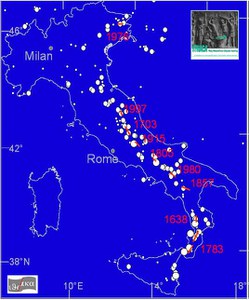ITaly HAzards from CApable faulting
The estimation of hazard derived from earthquakes and surface faulting is an important issue especially in densely populated and industrialized areas as the Italian territory is.
Consequently, mapping and characterizing capable faults assume a key role for the risk mitigation. To this purpose, the Geological Survey of Italy - ISPRA (Italian National Institute for Environmental Protection and Research) has developed the ITHACA project (ITaly HAzard from CApable faults).
ITHACA is a database aimed at collecting and analyzing all available information on active tectonic structures in Italy, with particular regard to tectonic processes able to generate natural hazards. The project deals with active capable faults, which are defined as faults that have significant potential for displacement at or near the ground surface.
The database of capable faults is an important tool for a) environmental and seismic hazards analysis, b) understanding of evolving landscape, c) land-use planning, d) Civil Protection emergency management. Moreover, it provides further elements for a more precise evaluation of geodynamic processes.
The first release of ITHACA database was presented during the 2000 IGC in Rio. Since then, the work has continued to improve the database. Presently, there is not a new comprehensive version available. However, many data on Northern and Southern Italy have changed. Many faults have been reviewed, some removed, others added. More information is available on many faults. More specifically, so far this review has regarded Northern Italy, where, although historically seismicity has been less relevant with respect to peninsular Italy, the density of population and infrastructures and the results of new specialist studies suggest a level of risk far from negligible and hence demand more attention even in areas considered quiet before. A significant improvement has received the database for Calabria and Sicily. For the latter also some offshore structures have been introduced (so far, Ionian Sea and Sicily Channel), which, despite the modest knowledge, are certainly active and capable of producing significant effects, including tsunamis, in the surrounding coastal areas.
Work is ongoing to update data also in the rest of Italy.

